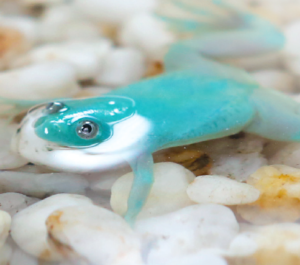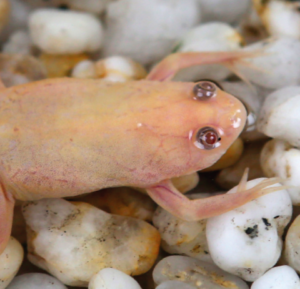Frogs are not the mainstream pets you can find in an average home. Some people even have
ranidaphobia, which is the fear of frogs; or bufonophobia, which is the fear of toads. Many people would be alarmed to learn that there are frogs with ‘claws’ (more on this later), but this is fairly normal. Read on to learn more.
The Basics
Often misunderstood even though they are encountered by most people when they go through high school, frogs and toads are nonetheless important to our ecosystem. African clawed frogs
range from 2 to over 5 inches in body length, with females being significantly larger than males. The tadpoles are fairly transparent with catfish-like whiskers. These frogs can live for 12-20 years in captivity.
African clawed frogs have smooth skin which is often mottled. This ranges from olive to brown in color on their backs and creamy white on their bellies. This ‘normal’ color of is actually uncommon since the albino and the dyed-albino colors are often the ones available in the
local pet stores.
Their diet is mainly composed of fish, insects, and worms that can fit in their mouths and are swallowed whole. Interestingly, the African clawed frog also uses its arms to push prey inside their mouth or move the prey to a position that is easy for them to swallow.

Can They Be Good Pets?
African clawed frogs make great pets and are easy to maintain in any aquarium. Adults have excellent immune systems and are very hardy. The African clawed frog secretes a horrible-tasting mucus on their skin to defend themselves from predators. It is also able to lay dormant for up to a year buried in mud with just a hole for air during the dry season which is unfavorable for them, especially for breeding. It remains a common pet frog readily available in pet stores, but with their lengthy life span, always make sure you are ready for a long term commitment in keeping this species.
Uses in Fields of Medicine
Today, the African clawed frog is used in various types of research such as developmental, cellular, and molecular biological studies. It has been in the pet trade since the early 1900s
but later became a laboratory specimen used for scientific research during the 1940s, primarily as an animal for human pregnancy testing. Referred to as the ‘Hogben test’, a female African clawed frog lays eggs when injected in the hind leg with a pregnant woman’s urine. This is because the human chorionic gonadotropin in the urine (the ‘pregnancy hormone’) would stimulate ovulation in the frog.
The latest product to come out of research on the African Clawed frog is pexiganan, an antimicrobial drug said to be a solution for antibiotic resistance among diabetic patients. According to study authors, “The results support the potential of topical pexiganan as
a therapeutic alternative to an orally administered antibiotic for treating mildly infected diabetic foot ulcers.” Pexiganan works by mimicking the functions of the innate immune system of the African clawed frog.
Unfortunately, this progress has a price. When new methods of pregnancy testing emerged, African clawed frog specimens were released in to the wild from the laboratories—and this resulted in it becoming a known invasive species in many parts of the globe.
A Cautionary Tale
At Animal Scene, we always work to educate readers about the consequences that too many casual hobbyists don’t think about, and the African clawed frog is a good example of what happens when an animal is taken out of its natural habitat then set free elsewhere. While it is important to the ecosystem, there are those who think that introducing the African clawed frogs to other waters will not do any good for the frogs. Native to Eastern and Southern Africa, African clawed frogs have also been introduced to North America, Europe, and South
America.
Now, the African clawed frogs are an established invasive species in the areas they were introduced to by some irresponsible pet owners and laboratories. They have successfully
established their population in these places because of their adaptability, diet diversity, effective immune system with disease resistance, high reproductive rate, and long life span.
As an invasive species, it poses a threat to the local fish species in the area; it also competes with other species such as local frogs and some predatory fish. They have no natural predators in the places they were introduced to, and no ecological role or niche in the ecosystem.
As a result, it is just a matter of time before they have a significant detrimental effect
to the local population of aquatic species in the areas they were introduced to.
There are other consequences of their having been irresponsibly introduced into non-native ecosystems. Along with the American bullfrog, the African clawed frog is suspected to be a carrier of a fungal skin disease, chytridiomycosis, which is caused by Batrachochytrium dendrobatidis on frogs and toads and has been identified as the cause of the mass mortality
of frogs and toads across the globe.
Chytridiomycosis has affected about 400 species of frogs and toads. Some species of frogs and toads have been brought to the brink of extinction because of this disease.
In addition, according to the Smithsonian, Public Library of Science (PloS)-published research in 2006 showed that a majority of the frogs carrying the fungus reside in California in the United States; the journal commented, “The frogs can carry the disease for long periods
without being affected themselves, so researchers suspect that they may be the original vectors that introduced the fungus around the world—a sort of revenge for being used as egg-laying research subjects for all those years.

Humans are ethically responsible for this phenomenon since it was because of human intervention that the Batrachochytrium dendrobatidis were introduced to new places to
destroy numerous frog populations. Many countries work to avoid such scenarios, and so the animal trade is strictly regulated, especially with the animals that can establish themselves in the habitat of a new location. The local species of the ecosystem is always at risk
when introducing a foreign species.
Thus, Animal Scene advises hobbyists and pet owners to be very careful and not to release foreign species irresponsibly. Keep your pets carefully, and enjoy them on their own merits; when you make the commitment to keep an African clawed frog, it’s for a lifetime.
DID YOU KNOW:
· The family Pipidae to which the African clawed frog belongs lacks a tongue and visible ear?
· Male African clawed frogs lack vocal chords, which make them unable to make mating calls.
· The “claws” of these frogs aren’t African clawed frogs do not have true claws but has cornified tips instead
· During mating, every time a male fertilizes an egg inside the female’s body the fertilized egg is released by the female almost immediately after mating.
This appeared as “A Hardy Frog” in Animal Scene’s November 2015 issue.






